High Efficiency Electrospinning
Project Director: Dr. Ionut ENCULESCU
National Institute of Materials Physics
Funded by UEFISCDI (Autoritatea contractanta UEFISCDI)
Electrospinning represents an almost classic method of fabricating ultra fine polymer fibers. The idea of electrostatically spinning polymer ultrathin fibers is around since more than 70 years. A polymer solution is fed through a small opening, usually a syringe needle or a pipette, at its end a small droplet of polymer solution being formed. A high voltage is applied between the polymer solution feed and a collecting electrode. Under the influence of the electric field the droplet deforms, a so called Taylor cone being formed. Further increase of the applied voltage leads to either spinning of a polymer fiber from the Taylor cone towards the collecting electrode or to spraying of polymer droplets, processes known as electrospinning or electrospraying respectively. Experimental parameters such as sollution composition and viscosity, spinarette to collector distance and applied voltage control the process.
The method of electrospinning has numerous advantages. Properties of the fibers can be well controlled. The fibers are very thin and have a high length to diameter ratio, thereby providing a very large surface area per mass unit. A wide range of polymers can be processed in this manner including here natural polymers such as collagen, fibrinogen or polysaccharides. Is a method that allows one to deposit very thin polymer fibers, diameter down to few tens of nanometers.
Although the process is studied since long time ago, a scan through recent scientific literature presents the main shortcoming of the method, the low yield in terms of quantity of material produced.
Consequently, the consortium approaches a problem of high technical and scientific interest, namely to develop an alternative of the method in order to increase the efficiency of nanofiber fabrication through. We aim at replacing the classic syringe needle, pipette or other capillary with an array of metallic micrometer or submicrometer tubules prepared by a template approach.
The main objective of the project is to develop a highly efficient alternative of the electrospinning method for preparing polymer nanofibers. The fabrication process we will develop aims at using, instead of the classical spinnerets (syringes and pipettes), arrays of metallic micronic and submicronic tubules.

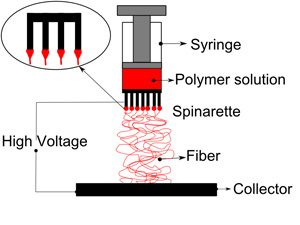
Secondary objectives will be the fabrication of functional metallic fibers and of products based on it for shielding applications and of complex fibers and fabrics for photovoltaic applications.
The outstanding properties of electrospun nanofibers make them optimal candidates for a broad range of applications in widely different areas such as protective clothing, filtration, high surface electrodes, catalysts and catalyst supports drug delivery substrates and so on.
The consortium represents a mixture between different type of research institutions, namely 2 National Institutes and 2 Universities and a private owned company with its activity focused on textile products, clothing and protective equipment. The aim of the consortium is to develop a new technology for increasing both the efficiency and the parameter control of an industrial process and to apply the technology for different products.
National Institute of Materials Physics – Coordinator (CO) http://www.infim.ro
Functional Nanostructures Group http://lab10.infim.ro/group1.html
National Institute of Lasers Plasma and Radiation Physics - Partner 1 (P1) http://www.inflpr.ro/en
Plasma Chemistry and Advanced Functional Materials Group http://www.inflpr.ro/ro/node/37
Technical University “Gheorghe Asachi” of Iasi - Partner 2 (P2) http://www.tuiasi.ro/
Electrical Engineering Faculty http://www.ee.tuiasi.ro/
University of Bucharest - Partner 3 (P3) http://www.unibuc.ro
Research Centre for Materials and Electronic and Optoelectronic Devices http://www.mdeo.eu/mdeo/main.asp
SC Adina SRL http://www.adina.com.ro/corporate/ http://www.echipamentemilitare.ro/
During the first step of the project the groups had two main goals:
(i) electrospinning in the classical approach of several polymers employing different solvents.
(ii) development of the method to cover the fibers with metal and to fabricate metallic tubules by a template approach.
One of the first polymers employed was PVP from sollutions in ethanol.
Other polymers employed were polymethylmetacrylate, nylon and polyvynilalcohol.
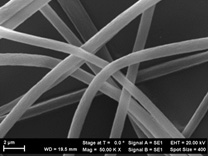 Electrospun PVP fibers
Electrospun PVP fibers
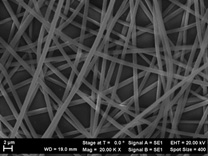
Electrospunn PMMA fibers
In each case we managed to produce smooth fibers with morphologies related to the deposition conditions.
In the second step we succeeded in improving the spinning process by means of spinning through microtubules and spinning using a textile, non-classic spinarette.
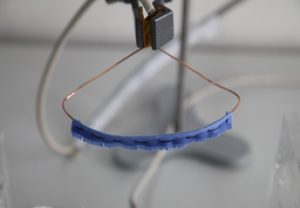
Simple set-up for efficient electrospinning using textile multijet spinarettes
We covered with metal fibers leading to transparent, flexible electrodes which can be applied on almost any substrate.
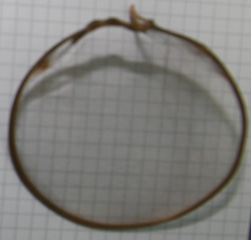 Electrospun metal covered electrode
Electrospun metal covered electrode
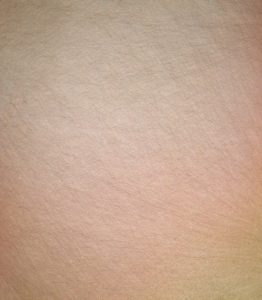
Electrospunn electrode on glass
We covered with electrospunn fibers textiles which are employed in protective clothing for increasing resistance.
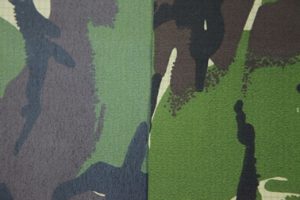 Nanofiber covered textle (left) compared to uncovered one (right)
Nanofiber covered textle (left) compared to uncovered one (right)
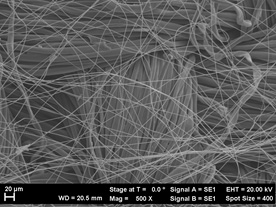
Microscopic detail of nanofiber covered textile
There are several members of the working teams which are students:
1. Alexandru Evanghelidis - Master Student
2. Andreea Costas PhD Student
3. Camelia FLorica PhD Student
Their theses are in the field of the project and deal with employing submicronic devices for obtaining extended functionalities.
Papers:
1. Influence of preparation conditions onto the properties of ZnO nanofibers obtained by electrospinning
Busuioc Cristina, Evanghelidis Alexandru Ionut, Florica Camelia, Costas Liliana Andreea, Enculescu Ionut-Marius
Patent applications:
1. Procedure for obtaining zinc oxide fibers with submicronic diameters by electrospinning polymethylmetacrylate solutions, Alexandru Evanghelidis, Cristina Busuioc, Monica Enculescu, Nicoleta Preda, Elena Matei, Camelia Florica, Andreea Costas, Mihaela Oancea, Ionut Enculescu
2. Procedure for fabricating transparent, flexible high quality electrodes based on electrospinning and electrochemical deposition, Alexandru Evanghelidis, Cristina Busuioc, Monica Enculescu, Nicoleta Preda, Elena Matei, Camelia Florica, Andreea Costas, Mihaela Oancea, Ionut Enculescu
An electrospinning machine was produced, enabling the fabrication of nonwoven maths with areas high enough for industrial applications.
By setting the parameters, the machine enables production of aligned nanofibers.
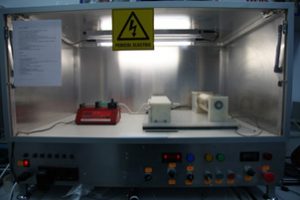
Equipment for electrospinning produced in the National Institute of Materials Physics
PROJECTS/ NATIONAL PROJECTS
Copyright © 2025 National Institute of Materials Physics. All Rights Reserved